The global automotive hydrogen leak detection sensors industry is projected to expand from USD 12.3 million to USD 38.4 million, recording an absolute gain of USD 26.1 million during the forecast horizon ending 2035. This progression reflects a compound annual growth rate of 12.5% and results in an industry that becomes more than three times larger compared with the baseline period starting 2025. The expansion demonstrates how safety monitoring is evolving from a supporting feature into a central requirement for hydrogen mobility platforms, hydrogen fueling infrastructure, and fuel cell vehicle systems.
In the early part of the cycle, the industry grows from USD 12.3 million to USD 21.7 million, representing an increase of USD 9.4 million during the years ending 2030. This accounts for 36% of the decade’s expansion. Growth at this stage is primarily driven by increasing pilot deployment of hydrogen vehicles, where safety compliance is critical for regulatory approval and consumer acceptance. Automotive OEMs and fuel cell system developers adopt sensor solutions to ensure accurate leak detection in compact vehicle architectures. Enhanced real-time monitoring capabilities, calibration accuracy, and compact form factors transition from premium features into expected standards. As a result, the market at this stage is defined by high adoption intensity in early-adopter regions such as Japan, Korea, Germany, and California by the end of 2030.
The following years demonstrate stronger acceleration, with the industry rising from USD 21.7 million to USD 38.4 million and adding USD 16.7 million during the phase ending 2035. This represents 64% of the decade’s expansion, showing that demand intensifies as hydrogen vehicles enter mass-market production and as fueling infrastructure scales. Integration of sensors into comprehensive vehicle safety platforms and smart control systems becomes a dominant trend. The value of the market nearly doubles in just five years, underscoring how compounding growth is reinforced by regulatory standards, government-backed hydrogen adoption policies, and the increasing role of fuel cells in heavy-duty transport.
The trajectory also signals a shift in competitive differentiation. Early years emphasize engineering precision and pilot adoption, while later years prioritize cost efficiency, mass production compatibility, and interoperability with global hydrogen fueling networks. By the time the cycle concludes in 2035, automotive hydrogen leak detection sensors are expected to be embedded not just in vehicles but also in hydrogen refueling stations and distributed infrastructure, creating multi-application revenue streams.
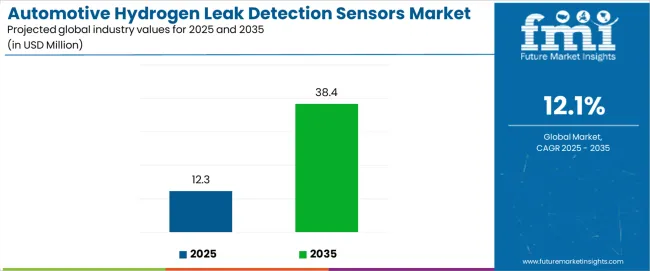
| Period | Primary Revenue Buckets | Share | Notes |
|---|---|---|---|
| Today | MOS-type hydrogen sensors | 52% | Proven technology, established automotive applications |
| Catalytic-type sensors | 31% | High sensitivity, fuel cell applications | |
| Electrochemical sensors | 17% | Precision detection, specialized applications | |
| Future (3-5 yrs) | Advanced MOS systems | 45-48% | Enhanced durability, temperature resistance |
| Smart catalytic sensors | 28-32% | IoT connectivity, predictive capabilities | |
| Fuel cell stack applications | 15-18% | Integrated monitoring, OEM partnerships | |
| Hydrogen tank monitoring | 12-16% | High-pressure applications, safety-critical | |
| Infrastructure applications | 8-12% | Filling stations, maintenance facilities | |
| Aftermarket & replacement | 6-10% | Service centers, retrofit installations |
At-a-Glance Metrics
| Metric | Value |
|---|---|
| Market Value (2025) | USD 12.3 million |
| Market Forecast (2035) | USD 38.4 million |
| Growth Rate | 12.1% CAGR |
| Leading Sensor Type | MOS-type Sensors |
| Primary Application | Fuel Cell Stack Segment |
The automotive hydrogen leak detection sensors market demonstrates strong fundamentals with MOS-type sensor systems capturing a dominant share through proven detection reliability and automotive application optimization. Fuel cell stack applications drive primary demand, supported by increasing hydrogen vehicle production and automotive safety requirements. Geographic expansion remains concentrated in developed markets with established hydrogen infrastructure, while emerging economies show accelerating adoption rates driven by automotive industry modernization initiatives and rising safety standards.
Primary Classification: The automotive hydrogen leak detection sensors market segments by sensor type into MOS-type, catalytic-type, and others, representing the evolution from traditional detection methods to sophisticated multi-parameter sensing systems for comprehensive hydrogen leak monitoring optimization.
Secondary Classification: Application segmentation divides the automotive hydrogen leak detection sensors market into fuel cell stack, hydrogen tank, infrastructure monitoring, and others, reflecting distinct requirements for detection sensitivity, response time, and integration specifications.
Tertiary Classification: End-use segmentation covers automotive OEMs, fuel cell manufacturers, hydrogen infrastructure operators, aftermarket service providers, and research institutions, while distribution channels span direct sales, automotive suppliers, and specialized safety equipment distributors.
Regional Classification: Geographic distribution covers North America, Latin America, Western Europe, Eastern Europe, East Asia, South Asia Pacific, and Middle East & Africa, with developed markets leading adoption while emerging economies show accelerating growth patterns driven by hydrogen mobility development programs.
The segmentation structure reveals sensor progression from traditional MOS-type detectors toward sophisticated multi-parameter systems with enhanced automotive integration capabilities, while application diversity spans from fuel cell vehicles to hydrogen refueling infrastructure requiring precision detection solutions.
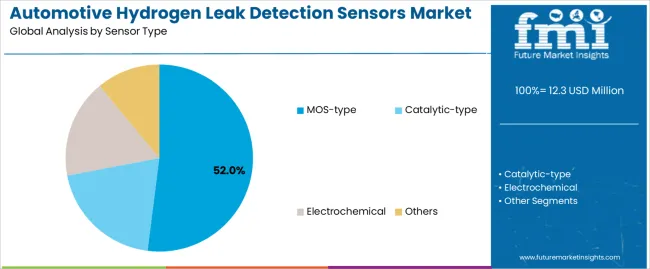
Market Position: MOS-type sensor systems command the leading position in the automotive hydrogen leak detection market with 52% market share through proven detection technologies, including fast response characteristics, automotive-grade durability, and cost-effective manufacturing that enable automotive manufacturers to achieve optimal safety monitoring across diverse hydrogen vehicle and infrastructure environments.
Value Drivers: The segment benefits from automotive industry preference for established sensor technologies that provide reliable detection, proven automotive compatibility, and operational durability without requiring exotic sensing infrastructure. Advanced MOS processing features enable enhanced temperature resistance, automotive EMC compliance, and integration with existing vehicle safety systems, where detection performance and cost effectiveness represent critical operational requirements.
Competitive Advantages: MOS-type sensor systems differentiate through proven automotive reliability, cost-effective production scaling, and integration with established safety management systems that enhance vehicle effectiveness while maintaining optimal detection standards suitable for diverse automotive applications.
Key market characteristics:
Catalytic-type sensor systems maintain a 31% market position in the automotive hydrogen leak detection market due to their high-sensitivity advantages and precision detection positioning benefits. These sensors appeal to applications requiring ultra-sensitive detection capabilities with enhanced selectivity profiles for critical safety operations. Market growth is driven by fuel cell vehicle expansion, emphasizing high-performance detection solutions and operational safety through optimized sensitivity designs.
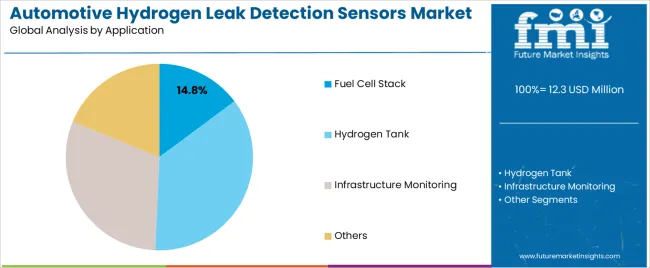
Market Context: Fuel cell stack applications demonstrate strong growth in the automotive hydrogen leak detection market with 14.8% CAGR due to widespread adoption of hydrogen fuel cell vehicles and increasing focus on automotive safety excellence, operational cost efficiency, and leak prevention applications that maximize detection effectiveness while maintaining vehicle performance standards.
Appeal Factors: Automotive manufacturers prioritize sensor reliability, detection accuracy, and integration with existing fuel cell infrastructure that enables coordinated safety operations across multiple vehicle systems. The segment benefits from substantial automotive industry investment and fuel cell development programs that emphasize the acquisition of advanced sensors for safety optimization and performance applications.
Growth Drivers: Fuel cell vehicle expansion programs incorporate leak detection sensors as essential components for safety operations, while automotive electrification growth increases demand for sensor capabilities that comply with safety standards and minimize operational complexity.
Market Challenges: Varying automotive standards and integration complexity may limit sensor standardization across different manufacturers or vehicle platforms.
Application dynamics include:
Hydrogen tank applications capture 35% market share through specialized high-pressure monitoring requirements in fuel storage systems, vehicle tanks, and safety applications. These systems demand precision sensors capable of supporting pressure vessel safety while providing leak detection access and operational monitoring capabilities.
Infrastructure monitoring applications account for 28% market share, including refueling stations, maintenance facilities, and service operations requiring comprehensive detection capabilities for safety optimization and operational effectiveness.
Market Context: Automotive OEMs dominate the automotive hydrogen leak detection sensors market with a 13.2% CAGR, reflecting the primary demand source for hydrogen leak detection sensor technology in vehicle applications and safety standardization.
Business Model Advantages: Automotive OEMs provide direct market demand for integrated sensor systems, driving volume production and cost optimization while maintaining quality control and safety consistency requirements.
Operational Benefits: Automotive OEM applications include safety standardization, cost efficiency, and quality assurance that drive consistent demand for sensor systems while providing access to the latest detection technologies.
| Category | Factor | Impact | Why It Matters |
|---|---|---|---|
| Driver | Hydrogen vehicle adoption & automotive electrification (fuel cell vehicles, commercial applications) | ★★★★★ | Growing hydrogen mobility market requires advanced leak detection with enhanced safety capabilities and monitoring properties proven effective across automotive applications. |
| Driver | Safety regulations advancement & automotive standards (ISO 26262, automotive safety) | ★★★★★ | Transforms detection requirements from "basic sensing" to "critical safety monitoring"; manufacturers that offer compliant sensors and safety features gain competitive advantage. |
| Driver | Hydrogen infrastructure development & refueling network (station expansion, infrastructure investment) | ★★★★☆ | Infrastructure operators need comprehensive, high-reliability sensors; demand for integrated and superior detection solutions expanding addressable market. |
| Restraint | Cost pressures & technology barriers (especially for smaller manufacturers) | ★★★★☆ | Smaller automotive suppliers defer sensor upgrades; increases price sensitivity and slows advanced detection adoption in cost-conscious markets. |
| Restraint | Alternative detection technologies competition (traditional gas sensors, optical systems) | ★★★☆☆ | Standard gas detection alternatives offer established supply chains and lower costs, potentially limiting hydrogen-specific sensor adoption in traditional applications. |
| Trend | Smart sensor integration & IoT connectivity (wireless monitoring, predictive maintenance) | ★★★★★ | Advanced connectivity features, real-time monitoring, and predictive analytics transform operations; IoT integration and smart capabilities become core value propositions. |
| Trend | Miniaturization & automotive integration (compact designs, ECU integration) | ★★★★☆ | Compact sensors for specific automotive platforms and applications; specialized designs and automotive integration capabilities drive competition toward miniaturization solutions. |
The automotive hydrogen leak detection sensors market demonstrates varied regional dynamics with Growth Leaders including China (16.3% growth rate) and India (15.1% growth rate) driving expansion through hydrogen mobility development initiatives and automotive industry modernization. Steady Performers encompass Germany (13.9% growth rate), Brazil (12.7% growth rate), and developed regions, benefiting from established automotive industries and hydrogen infrastructure adoption. Mature Markets feature United States (11.5% growth rate), United Kingdom (10.3% growth rate), and Japan (9.1% growth rate), where automotive advancement and safety standardization requirements support consistent growth patterns.
Regional synthesis reveals East Asian markets leading adoption through automotive electrification and hydrogen infrastructure development, while North American countries maintain steady expansion supported by sensor technology advancement and safety standardization requirements. European markets show strong growth driven by automotive applications and regulatory compliance trends.
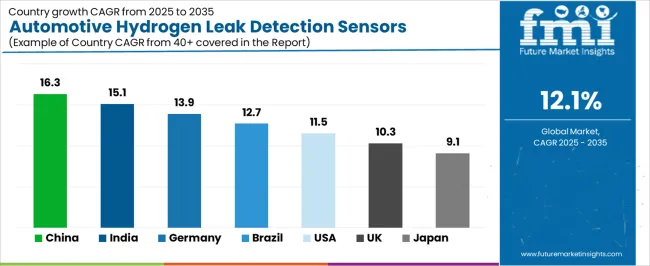
| Region/Country | 2025 to 2035 Growth | How to win | What to watch out |
|---|---|---|---|
| China | 16.3% | Focus on automotive OEM partnerships | Regulatory changes; local competition |
| India | 15.1% | Lead with cost-effective manufacturing | Import restrictions; technology barriers |
| Germany | 13.9% | Provide premium automotive sensors | Over-regulation; lengthy approvals |
| Brazil | 12.7% | Offer value-oriented solutions | Currency fluctuations; import duties |
| United States | 11.5% | Push technology integration | Compliance costs; scaling challenges |
| United Kingdom | 10.3% | Focus on automotive applications | Economic impacts; sensor costs |
| Japan | 9.1% | Emphasize precision manufacturing | Traditional preferences; adoption rates |
China establishes fastest market growth through aggressive hydrogen mobility development programs and comprehensive automotive industry expansion, integrating advanced hydrogen leak detection sensors as standard components in fuel cell vehicles and hydrogen infrastructure installations. The country's 16.3% growth rate reflects government initiatives promoting hydrogen economy development and domestic sensor manufacturing capabilities that mandate the use of professional detection systems in automotive and infrastructure facilities. Growth concentrates in major automotive hubs, including Beijing, Shanghai, and Shenzhen, where hydrogen vehicle development showcases integrated sensor systems that appeal to automotive manufacturers seeking safety optimization capabilities and operational applications.
Chinese manufacturers are developing cost-effective sensor solutions that combine domestic production advantages with advanced detection features, including enhanced automotive compliance and improved performance capabilities. Distribution channels through automotive suppliers and safety equipment distributors expand market access, while government support for hydrogen economy development supports adoption across diverse automotive and infrastructure segments.
Strategic Market Indicators:
In Mumbai, Delhi, and Bangalore, automotive facilities and hydrogen infrastructure operators are implementing professional leak detection sensor systems as standard equipment for safety monitoring and operational optimization applications, driven by increasing government automotive investment and hydrogen economy modernization programs that emphasize the importance of safety monitoring capabilities. The automotive hydrogen leak detection sensors market holds a 15.1% growth rate, supported by government automotive initiatives and hydrogen development programs that promote professional sensor systems for vehicle and infrastructure facilities. Indian operators are adopting sensor systems that provide consistent safety monitoring and detection features, particularly appealing in urban regions where automotive safety and operational excellence represent critical business requirements.
Market expansion benefits from growing automotive capabilities and international technology partnerships that enable domestic production of professional sensor systems for automotive and infrastructure applications. Technology adoption follows patterns established in automotive safety equipment, where reliability and performance drive procurement decisions and operational deployment.
Market Intelligence Brief:
Germany's advanced automotive market demonstrates sophisticated hydrogen leak detection sensor deployment with documented safety effectiveness in automotive applications and infrastructure facilities through integration with existing automotive systems and operational infrastructure. The country leverages engineering expertise in automotive sensors and safety systems integration to maintain a 13.9% growth rate. Automotive centers, including Bavaria, Baden-Württemberg, and Lower Saxony, showcase premium installations where sensor systems integrate with comprehensive automotive platforms and safety management systems to optimize detection performance and operational effectiveness.
German manufacturers prioritize system quality and automotive compliance in sensor development, creating demand for premium systems with advanced features, including vehicle integration and safety monitoring systems. The automotive hydrogen leak detection sensors market benefits from established automotive infrastructure and a willingness to invest in professional sensor technologies that provide long-term operational benefits and compliance with international automotive standards.
Market Intelligence Brief:
Brazil's market expansion benefits from diverse automotive demand, including hydrogen mobility modernization in São Paulo and Rio de Janeiro, automotive facility upgrades, and government automotive programs that increasingly incorporate professional sensor solutions for safety applications. The country maintains a 12.7% growth rate, driven by rising automotive activity and increasing recognition of professional sensor benefits, including precise detection control and enhanced operational effectiveness.
Market dynamics focus on cost-effective sensor solutions that balance safety monitoring performance with affordability considerations important to Brazilian automotive operators. Growing automotive industrialization creates continued demand for modern sensor systems in new automotive infrastructure and facility modernization projects.
Strategic Market Considerations:
United States establishes market leadership through comprehensive automotive programs and advanced hydrogen infrastructure development, integrating hydrogen leak detection sensors across vehicle and infrastructure applications. The country's 11.5% growth rate reflects established automotive industry relationships and mature sensor technology adoption that supports widespread use of professional detection systems in automotive and infrastructure facilities. Growth concentrates in major automotive centers, including California, Michigan, and Texas, where sensor technology showcases mature deployment that appeals to automotive operators seeking proven safety capabilities and operational efficiency applications.
American automotive providers leverage established distribution networks and comprehensive technical support capabilities, including calibration programs and training support that create customer relationships and operational advantages. The automotive hydrogen leak detection sensors market benefits from mature regulatory standards and automotive requirements that mandate sensor system use while supporting technology advancement and operational optimization.
Market Intelligence Brief:
United Kingdom's automotive market demonstrates integrated hydrogen leak detection sensor deployment with documented safety effectiveness in automotive applications and infrastructure facilities through integration with existing automotive systems and operational infrastructure. The country maintains a 10.3% growth rate, supported by automotive excellence programs and safety effectiveness requirements that promote professional sensor systems for automotive applications. Automotive facilities across England, Scotland, and Wales showcase systematic installations where sensor systems integrate with comprehensive automotive platforms to optimize safety monitoring and operational outcomes.
UK automotive providers prioritize system reliability and industry compatibility in sensor procurement, creating demand for validated systems with proven safety features, including performance monitoring integration and detection accuracy systems. The automotive hydrogen leak detection sensors market benefits from established automotive infrastructure and excellence requirements that support sensor technology adoption and operational effectiveness.
Market Intelligence Brief:
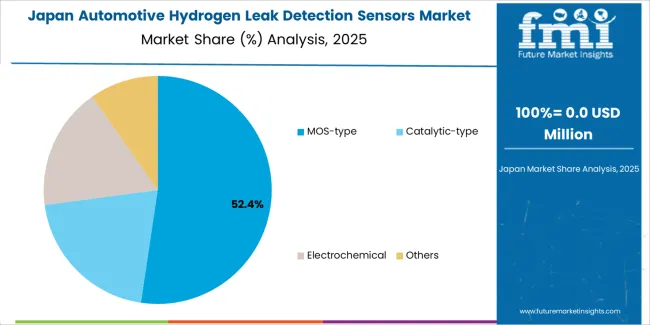
Japan's market growth benefits from precision automotive demand, including advanced hydrogen vehicle facilities in Tokyo and Osaka, quality integration, and safety enhancement programs that increasingly incorporate sensor solutions for detection applications. The country maintains a 9.1% growth rate, driven by automotive technology advancement and increasing recognition of precision sensor benefits, including accurate detection control and enhanced safety outcomes.
Market dynamics focus on high-precision sensor solutions that meet Japanese quality standards and detection effectiveness requirements important to automotive operators. Advanced automotive technology adoption creates continued demand for sophisticated sensor systems in vehicle infrastructure and safety modernization projects.
Strategic Market Considerations:
The European automotive hydrogen leak detection sensors market is projected to grow from USD 2.8 million in 2025 to USD 9.2 million by 2035, registering a CAGR of 12.8% over the forecast period. Germany is expected to maintain its leadership position with a 42.1% market share in 2025, supported by its advanced automotive infrastructure and major hydrogen development centers.
United Kingdom follows with a 26.3% share in 2025, driven by comprehensive automotive programs and hydrogen safety development initiatives. France holds a 15.7% share through specialized automotive applications and safety compliance requirements. Italy commands a 9.2% share, while Spain accounts for 4.1% in 2025. The rest of Europe region is anticipated to gain momentum, expanding its collective share from 2.6% to 3.8% by 2035, attributed to increasing automotive adoption in Nordic countries and emerging hydrogen facilities implementing automotive modernization programs.
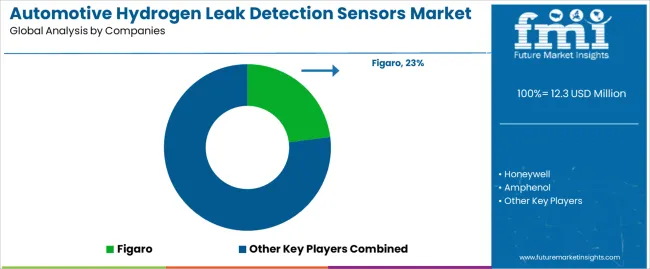
| Stakeholder | What they actually control | Typical strengths | Typical blind spots |
|---|---|---|---|
| Global brands | Distribution reach, broad product catalogs, automotive partnerships | Wide availability, proven quality, multi-region support | Product refresh cycles; customer dependency on automotive validation |
| Technology innovators | Sensor R&D; advanced detection technologies; enhanced automotive integration | Latest technologies first; attractive ROI on safety effectiveness | Service density outside core regions; scaling complexity |
| Regional specialists | Local compliance, fast delivery, nearby customer support | "Close to customer" support; pragmatic pricing; local regulations | Technology gaps; talent retention in customer service |
| Full-service providers | Sensor programs, calibration services, system integration | Lowest operational risk; comprehensive support | Service costs if overpromised; technology obsolescence |
| Niche specialists | Specialized applications, custom sensors, automotive services | Win premium applications; flexible configurations | Scalability limitations; narrow market focus |
| Item | Value |
|---|---|
| Quantitative Units | USD 12.3 million |
| Sensor Type | MOS-type, Catalytic-type, Electrochemical, Others |
| Application | Fuel Cell Stack, Hydrogen Tank, Infrastructure Monitoring, Others |
| End Use | Automotive OEMs, Fuel Cell Manufacturers, Hydrogen Infrastructure Operators, Aftermarket Service Providers, Research Institutions |
| Regions Covered | North America, Latin America, Western Europe, Eastern Europe, East Asia, South Asia Pacific, Middle East & Africa |
| Countries Covered | China, India, Germany, Brazil, United States, United Kingdom, Japan, Canada, France, Australia, and 25+ additional countries |
| Key Companies Profiled | Figaro, Honeywell, Amphenol, Membrapor, Nissha FIS, First Sensor, NTM Sensors, Sensirion, ProSense Technologies |
| Additional Attributes | Dollar sales by sensor type and application categories, regional adoption trends across East Asia, North America, and Western Europe, competitive landscape with sensor manufacturers and automotive suppliers, automotive operator preferences for detection effectiveness and safety monitoring, integration with automotive platforms and safety management systems, innovations in sensor technology and detection enhancement, and development of advanced sensor solutions with enhanced performance and automotive optimization capabilities. |
The global automotive hydrogen leak detection sensors market is estimated to be valued at USD 12.3 million in 2025.
The market size for the automotive hydrogen leak detection sensors market is projected to reach USD 38.4 million by 2035.
The automotive hydrogen leak detection sensors market is expected to grow at a 12.1% CAGR between 2025 and 2035.
The key product types in automotive hydrogen leak detection sensors market are mos-type, catalytic-type, electrochemical and others.
In terms of application, fuel cell stack segment to command 14.8% share in the automotive hydrogen leak detection sensors market in 2025.






Full Research Suite comprises of:
Market outlook & trends analysis
Interviews & case studies
Strategic recommendations
Vendor profiles & capabilities analysis
5-year forecasts
8 regions and 60+ country-level data splits
Market segment data splits
12 months of continuous data updates
DELIVERED AS:
PDF EXCEL ONLINE
Automotive Seating Market Size and Share Forecast Outlook 2025 to 2035
Automotive Appearance Chemical Market Size and Share Forecast Outlook 2025 to 2035
Automotive Remote Diagnostic Market Size and Share Forecast Outlook 2025 to 2035
Automotive-grade Inertial Navigation System Market Size and Share Forecast Outlook 2025 to 2035
Automotive Thin IGBT Module Market Size and Share Forecast Outlook 2025 to 2035
Automotive Hybrid IGBTs Market Size and Share Forecast Outlook 2025 to 2035
Automotive Exhaust Extraction Hose Reels Market Size and Share Forecast Outlook 2025 to 2035
Automotive Electroplating Service Market Size and Share Forecast Outlook 2025 to 2035
Automotive Manufacturing Equipment Market Size and Share Forecast Outlook 2025 to 2035
Automotive Pressure Sensor Market Size and Share Forecast Outlook 2025 to 2035
Automotive Vacuum Brake Booster Market Size and Share Forecast Outlook 2025 to 2035
Automotive Smart Antenna Market Size and Share Forecast Outlook 2025 to 2035
Automotive Actuator Market Size and Share Forecast Outlook 2025 to 2035
Automotive Exhaust Manifold Market Size and Share Forecast Outlook 2025 to 2035
Automotive Roof Rails Market Size and Share Forecast Outlook 2025 to 2035
Automotive Resonator Market Size and Share Forecast Outlook 2025 to 2035
Automotive Counter Shaft Market Size and Share Forecast Outlook 2025 to 2035
Automotive Wheel Coating Market Size and Share Forecast Outlook 2025 to 2035
Automotive Water Separation Systems Market Size and Share Forecast Outlook 2025 to 2035
Automotive Refinish Coating Market Size and Share Forecast Outlook 2025 to 2035

Thank you!
You will receive an email from our Business Development Manager. Please be sure to check your SPAM/JUNK folder too.
Chat With
MaRIA